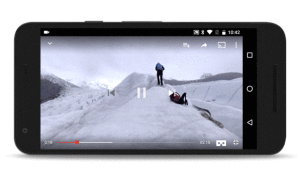New York Times Virtual-Reality Documentary Is Moving But Occasionally Nauseating
 There were many other striking moments. But some were marred by the limitations of the technology. When the camera put me inside Chuol’s canoe as he pushed it out of a bank of reeds into a swamp the scene was beautiful, but I felt motion-sick. The sensation returned when the camera rode along with 11-year-old Oleg in Ukraine and his friends on their bikes.
There were many other striking moments. But some were marred by the limitations of the technology. When the camera put me inside Chuol’s canoe as he pushed it out of a bank of reeds into a swamp the scene was beautiful, but I felt motion-sick. The sensation returned when the camera rode along with 11-year-old Oleg in Ukraine and his friends on their bikes.
Those scenes might have been less biologically troubling had I been using higher quality virtual reality hardware. The Oculus Rift headset launching next year is better at minimizing the lag between the motion of a virtual world and that of your head, which is one cause of motion sickness. But badly chosen or design content can make you sick, too. Filmmakers have much to learn about what kind of footage they can get away with. I’d say that at 11 minutes the New York Times documentary is slightly too long for the current state of mobile virtual reality technology and the art of immersive 3-D filmmaking.
The new VR video footage I tried on YouTube didn’t make me feel so woozy, even when, for example in this clip, you are placed on a ferry moving away from a city. In that case, Google employees working on virtual reality told me that they carefully chose a clip in which the ferry moved with a constant velocity. Most people are okay with smooth motion, they said; it is changes in speed that cause problems.
See the full story here: http://www.technologyreview.com/view/543216/new-york-times-virtual-reality-documentary-is-moving-but-occasionally-nauseating/
Pages
- About Philip Lelyveld
- Mark and Addie Lelyveld Biographies
- Presentations and articles
- Tufts Alumni Bio